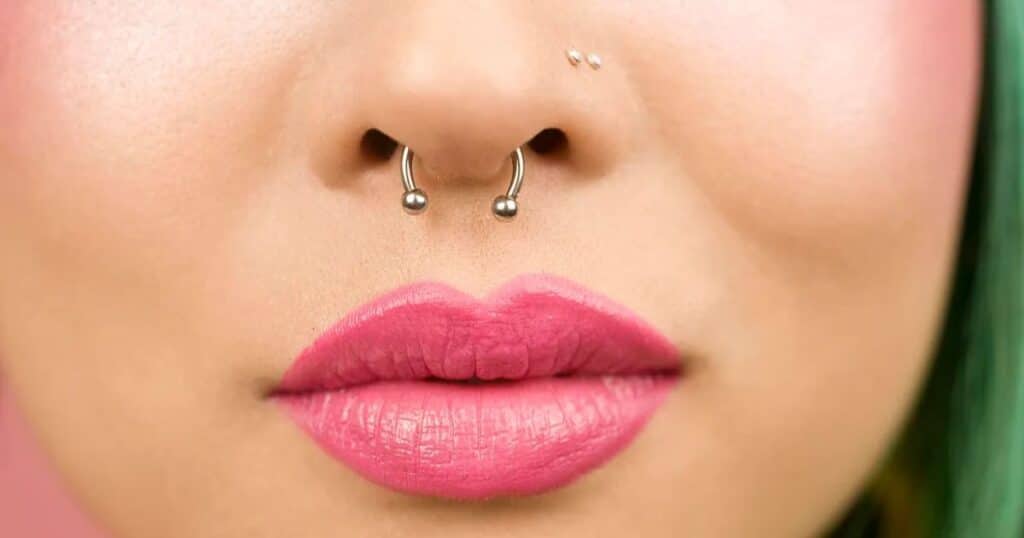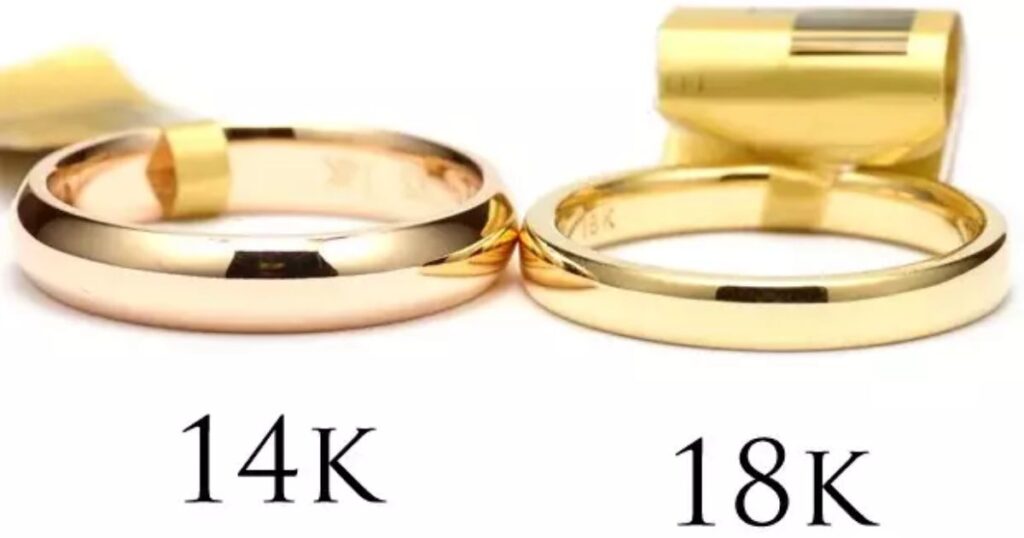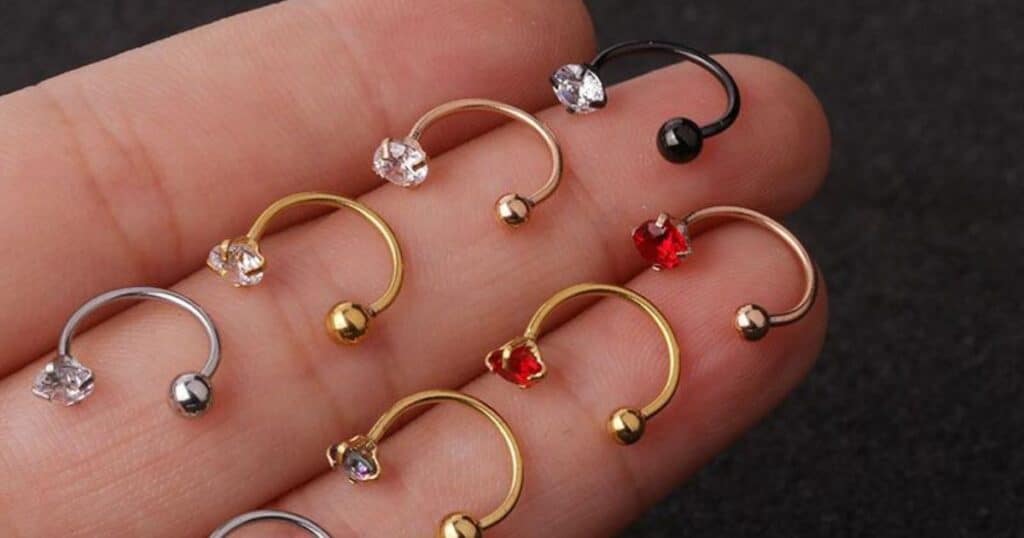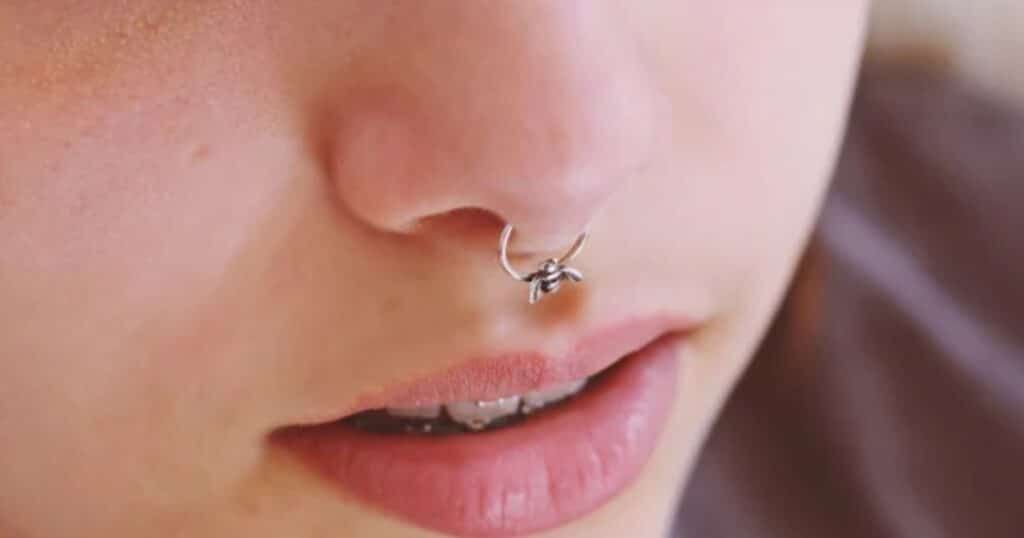Septum Ring Sizes: What Gauge Is a Septum Piercing?
A septum piercing is a unique and eye-catching facial piercing that has gained immense popularity in recent years. But, many people are unsure about the right gauge and size for a septum ring. This comprehensive guide will help you understand septum ring sizes, gauge measurements, and the different types of jewelry suitable for this piercing.
Septum Ring Sizes
Septum ring sizes come in two main parts: gauge and inner diameter.
- Gauge refers to the thickness of the jewelry, typically listed as 16g or 18g. Lower numbers mean thicker jewelry. The most common gauge for septum piercings is 16g (1.2mm), but your piercer may recommend a different gauge depending on your anatomy and preferences.
- Inner diameter is the measurement from the inner edge of one side of the hoop to the other. Septum rings come in a variety of inner diameters, from 6mm to 16mm. The size you choose will depend on your personal preference and anatomy. A good rule of thumb is to start with a larger diameter (8mm or 10mm) and then size down once your piercing has healed.
Here are some additional things to keep in mind when choosing a septum ring size:
- The size of your septum. If you have a small septum, you will want to choose a smaller diameter ring.
- The look you are going for. Do you want a ring that hugs your nose closely, or one that hangs down a bit?
- Your comfort level. A ring that is too tight will be uncomfortable, and a ring that is too loose may fall out.
It is always best to consult with a professional piercer to get advice on the best septum ring size for you. They can take your measurements and help you choose a ring that is both stylish and comfortable.
What Gauge is a Septum Piercing?

A septum piercing is typically done with a 16 gauge (1.2mm) or 14 gauge (1.6mm) needle. These gauges are considered standard for initial septum piercings, as they provide a balance between comfort and ease of healing.
The gauge of a piercing refers to the thickness or diameter of the initial jewelry inserted into the piercing. It’s essential to start with an appropriate gauge to ensure proper healing and avoid complications such as excessive swelling, migration, or rejection.
According to professional piercers, 16 gauge is the most common gauge for septum piercings. It’s thick enough to withstand the natural movement of the nose and septum but still relatively thin and comfortable for the initial healing phase.
“We recommend starting with a 16 gauge septum piercing. It’s the perfect balance between stability and comfort.” – Emily Harington, Professional Piercer at Infinite Body Piercing
If you have a particularly thick or sturdy septum, your piercer may suggest starting with a 14 gauge. This slightly thicker gauge can provide additional support and stability for the piercing, but it may also result in slightly more swelling or discomfort during the initial healing phase.
Read More: Skims Dupes on Amazon – 8 Best Skims Dupes To Try
Septum Ring Diameter
The diameter of a septum ring refers to the interior circumference or the space inside the ring. This measurement is crucial because a ring that is too small can cause discomfort and potentially damage the piercing, while a ring that is too large may not fit properly or fall out easily.
When it comes to septum ring diameters, there are several standard sizes to choose from:
- 8mm (5/16 inch): This is a common starting size for fresh septum piercings, as it allows for some initial swelling.
- 10mm (3/8 inch): Once the piercing has fully healed, many people opt for a 10mm ring for a comfortable fit.
- 12mm (1/2 inch): This larger diameter is suitable for those with a wider “sweet spot” in their septum or for those who prefer a more pronounced look.
It’s crucial to choose the right diameter for your septum piercing to ensure a comfortable and secure fit. A ring that is too tight can cause discomfort, while a ring that is too loose may fall out or catch on clothing or objects.
What diameter septum ring should I get
The ideal diameter for a septum ring can vary depending on the individual’s anatomy and personal preference. Here are some general guidelines:
- For fresh septum piercings: Start with an 8mm (5/16 inch) diameter ring. This size allows for some initial swelling and ensures a comfortable fit during the healing process.
- For healed septum piercings: Once your piercing has fully healed (typically after 6-8 weeks), you can consider downsizing to a snugger fit. Many people opt for a 10mm (3/8 inch) ring, as it provides a comfortable and secure fit without being too tight or too loose.
- For those with a wider “sweet spot”: If you have a wider “sweet spot” (the area between the cartilage and the nasal bone where the jewelry sits), you may prefer a larger diameter ring, such as 12mm (1/2 inch). This size can create a more pronounced look and may be more comfortable for some individuals.
It’s important to note that everyone’s anatomy is different, and the ideal septum ring size may vary. If you’re unsure about the right size, consult with a professional piercer who can assess your specific needs and provide personalized recommendations.
How to Measure Septum Ring Diameter?
To ensure you get the right septum sizes ring, you can measure the diameter yourself using a simple technique:
- Gently insert a smooth, non-toxic object (like an unbent paper clip or a piece of jewelry) through your piercing.
- Mark the points where the object enters and exits your septum.
- Remove the object and measure the distance between the marks using a ruler or caliper.
- Add 1-2mm to this measurement to account for swelling and ensure a comfortable fit.
By taking accurate measurements and consulting with a professional piercer, you can find the perfect septum ring size that fits comfortably and securely without causing discomfort or falling out.
Recommended Materials for Septum Piercing Jewelry
When it comes to septum piercing jewelry, it’s essential to choose materials that are safe, hypoallergenic, and suitable for long-term wear. Here are some recommended materials for septum piercings:
1. Implant-grade titanium
Titanium is an excellent choice for septum piercings as it is hypoallergenic, lightweight, and highly biocompatible. It is ideal for those with metal sensitivities or nickel allergies. Implant-grade titanium is a high-quality material that is often used in medical implants, making it a safe and reliable option for body piercings.
2. 14K/18K gold

High-quality gold, such as 14K or 18K, is a popular and safe option for septum jewelry. Gold is hypoallergenic and tarnish-resistant, making it a luxurious and long-lasting choice. However, it’s important to ensure that the gold is solid and not plated, as plated jewelry can chip or wear off, exposing the underlying metal.
3. Medical-grade and surgical stainless steel
Surgical stainless steel is another hypoallergenic and affordable option for septum piercings. It is essential to ensure that the steel is medical-grade and nickel-free to avoid potential reactions. Stainless steel can be a durable and cost-effective choice for those without metal sensitivities.
While other materials like niobium, glass, and certain types of plastic (such as PTFE or Tygon) may also be suitable for septum piercings, it’s always best to consult with a professional piercer and follow their recommendations based on your individual needs and preferences.
Common types of septum piercing jewelry
When it comes to septum piercing jewelry, there are several popular options to choose from, each with its own pros and cons.
1. Curved Barbells

Curved barbells are a classic choice for septum piercings, offering a secure and comfortable fit.
Pros:
- Easy to insert and remove
- Suitable for fresh and healed piercings
- Variety of materials and designs available
Cons:
- Can be more visible than other options
- May require periodic tightening to prevent migration
2. Septum Piercing Rings

Septum rings are a popular and stylish option, available in various styles and materials.
Pros:
- Seamless, aesthetically pleasing look
- Can be worn discretely or prominently
- Wide range of designs and customization options
Cons:
- Can be more challenging to insert and remove
- May require a professional piercer for resizing
2.1 Captive bead rings
Captive bead rings are a type of septum ring with a small bead that secures the ring in place, making them a comfortable and secure option.
2.2 Septum clickers
Septum clickers are hinged rings that can be easily opened and closed, making them a convenient choice for those who prefer to change their jewelry frequently.
2.3 Plain nose ring or hoops
Simple nose rings or hoops can also be worn in a septum piercing, providing a subtle and minimalist look.
3. Fake septum piercing

For those who want the look of a septum piercing without the commitment, fake or clip-on septum jewelry is a non-permanent option. These pieces are designed to clip onto the septum area without requiring an actual piercing.
When choosing septum jewelry, it’s essential to consider factors like comfort, healing stage, personal style, and ease of insertion/removal. Consulting with a professional piercer can help you make an informed decision and ensure that your jewelry is safe, high-quality, and suitable for your needs.
Pata Pata Septum Jewelry Printable Sizing Chart
| Septum Ring Diameter | Recommended Usage |
|---|---|
| 8mm (5/16 inch) | Fresh septum piercings, allows for swelling |
| 10mm (3/8 inch) | Healed septum piercings, comfortable fit |
| 12mm (1/2 inch) | Wider “sweet spot,” pronounced look |
How Do I Know Which Size Septum Ring To Get?
To determine the right septum ring size, consider your anatomy, personal preferences, and the stage of healing. Consult with a professional piercer, measure your septum precisely, and start with a slightly larger diameter to accommodate swelling. As your piercing heals, you can downsize to a snugger and more comfortable fit.
Also Read: Haven Heart Gold Chain Bracelet In Multi Mix
What Type Of Jewelry Is Best For Septum Piercings?
The best jewelry for septum piercings is made from high-quality, hypoallergenic materials like implant-grade titanium, 14K/18K gold, or medical-grade stainless steel. Curved barbells, septum rings (including captive bead rings and clickers), and plain nose rings/hoops are popular choices. Ultimately, the right jewelry depends on your personal style, comfort, and healing stage.
“Choosing the right septum jewelry is crucial for comfort, healing, and overall satisfaction with your piercing. Take the time to research and consult with a professional piercer to find the perfect fit.” – Dr. Sarah Johnson, Board-Certified Dermatologist
By understanding septum ring sizes, gauges, and jewelry options, you can make an informed decision that ensures a comfortable and stylish septum piercing experience.
Understanding Rejected Septum Piercing: Causes and Symptoms
Septum piercings are undoubtedly a favored choice among many individuals, offering a unique style statement. But, there are instances where the body simply refuses to accept them, leading to what is commonly known as a “Rejected Septum Piercing.” This rejection can stem from various factors, ranging from errors in the piercing process itself to allergic responses triggered by the materials used in the jewelry.
Symptoms of such rejection are often unmistakable, manifesting as redness, swelling, pain, and discharge around the piercing site. Furthermore, the migration of the piercing, where it shifts from its original position, serves as a clear indication of rejection.
In such cases, it becomes imperative to seek professional assistance promptly. A trained piercer or healthcare provider can evaluate the situation and, if necessary, recommend the removal of the piercing to avert any further complications.
Some FAQ’s
What are the standard septum ring sizes?
Standard septum ring sizes typically range from 16 gauge (1.2mm) to 14 gauge (1.6mm), with diameters varying from 8mm to 12mm.
How do I measure my septum for the right ring size?
Use a flexible tape measure or a piece of string to measure the distance between your nostrils where you want the ring to sit. This measurement will help you determine the appropriate diameter for your septum ring.
Can I customize septum ring sizes?
Yes, many jewelry artisans offer custom sizing options for septum rings. You can also find septum rings with adjustable designs to accommodate various sizes.
Are there different types of septum rings based on size?
Yes, septum rings come in various styles, including captive bead rings, circular barbells, horseshoe rings, and clicker rings, each available in different sizes to suit individual preferences.
What should I do if my septum ring is too big/small?
If your septum ring is too big, you can visit a professional piercer to have it resized or consider purchasing a smaller size. If it’s too small, you may need to exchange it for a larger size or opt for a different style that offers better fit adjustability.
Final Words
A septum piercing is typically done with a 16 gauge (1.2mm) or 14 gauge (1.6mm) needle. Understanding septum piercing sizes is essential; for instance, 8mm diameter rings accommodate swelling in fresh piercings, while 10mm provides comfort for healed piercings, and 12mm suits wider “sweet spots”. Recommended materials for septum jewelry include implant-grade titanium, 14K/18K gold, and medical-grade stainless steel.
Popular jewelry options are curved barbells, septum rings (captive bead, clickers, hoops), and fake septum pieces. Proper sizing ensures comfort and prevents issues like discomfort, migration, or jewelry falling out. Consulting a professional piercer and measuring accurately is key to finding the ideal septum ring size and style.

Amara Rosewood, with 8 years of expertise in bracelet design, is the creative force behind BraceletsWare. Her passion and skill converge in each piece, crafting timeless accessories that redefine style.







